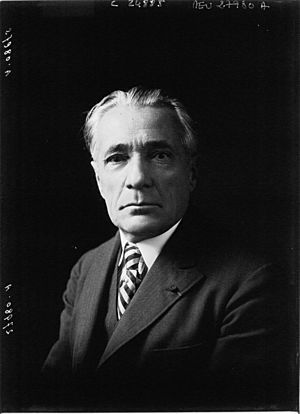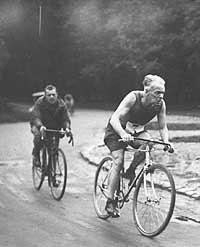Henri Desgrange facts for kids
Quick facts for kids
Henri Desgrange
|
|
|---|---|

Desgrange, c. 1925
|
|
| Born | 31 January 1865 |
| Died | 16 August 1940 (aged 75) Grimaud, France
|
| Nationality | French |
| Occupation | Competitive cyclist and sports journalist |
| Title | Director of the Tour de France |
| Term | 1903 – 1935 |
| Predecessor | new |
| Successor | Jacques Goddet |
Henri Desgrange (born January 31, 1865 – died August 16, 1940) was a French bicycle racer and sports journalist. He set many world track cycling records. This included the famous hour record of 35.325 kilometres (21.950 mi) on May 11, 1893. He is best known as the first organiser of the famous Tour de France bicycle race.
| Top - 0-9 A B C D E F G H I J K L M N O P Q R S T U V W X Y Z |
Early Life and Cycling Career
Henri Desgrange grew up in a comfortable family in Paris, France. He worked as a clerk in a law office. Some stories say he was fired for cycling to work or for wearing tight cycling clothes.
Desgrange saw his first bicycle race in 1891. He started racing on the track, but he was better at long-distance riding. On May 11, 1893, he set the first official "hour record." He rode 35.325 kilometres (21.950 mi) in one hour at the Buffalo velodrome in Paris. He also set records for 50 km, 100 km, and 100 miles. In 1893, he became a champion in tricycle racing.
In 1894, he wrote a training book called La tête et les jambes (The Head and the Legs). He also wrote another book, Alphonse Marcaux. Later, in 1897, he became the director of the Parc des Princes velodrome. In 1903, he also directed France's first indoor track, the Vélodrome d'Hiver, near the Eiffel Tower.
Journalism and L'Auto
Desgrange became the editor of a new sports newspaper called L'Auto-Vélo. This happened because he and other important people were unhappy with the main sports paper, Le Vélo. They didn't like its advertising prices or its political views.
The first issue of L'Auto-Vélo came out on October 16, 1900. It was printed on yellow paper to look different from Le Vélo, which was green. However, a court case in 1902 made them change the name. They had to drop "vélo" from the title, so the paper became L'Auto.
The Tour de France Race
Henri Desgrange is famous for starting the Tour de France in 1903. The idea actually came from one of his journalists, Géo Lefèvre. L'Auto announced the new race on January 19, 1903.
Promoting the Tour de France was a huge success for the newspaper. Its sales jumped from 25,000 copies before the race to 65,000 after it. By 1908, the race helped sales go over 250,000 copies. During the 1923 Tour, L'Auto was selling 500,000 copies a day! Desgrange said the highest sales ever were 854,000 copies during the 1933 Tour.
How Desgrange Managed the Race
Cycle racing grew very fast. Henri Desgrange saw his race as more important than the official French cycling group, the Union Vélocipédique Française (UVF).
In the 1904 Tour de France, the UVF disqualified the top four riders. Desgrange felt their punishments were too harsh. He was also annoyed that the UVF waited so long to announce their decision. He wrote in L'Auto that the public would want an explanation.
Desgrange even said that the Tour de France might end after only its second year. He wrote that it "has died of its success." However, he soon changed his mind and continued to run the Tour de France for another 30 years.
It was "his" Tour de France, and he made strict rules. For example, in 1920, French rider Henri Pélissier was penalized two minutes for leaving a flat tire by the roadside. In 1924, Pélissier and two other riders quit the race. This happened after an argument about whether riders could take off clothes as the day got hotter. Desgrange called Pélissier "a pigheaded, arrogant champion."
Marcel Bidot, another rider and later a team manager, described Desgrange as "a driven man and a boss who tolerated no disagreement."
Desgrange and World War I
At the start of World War I, Desgrange created a committee for physical education. He helped train thousands of soldiers for the front lines. Even though he was over 50, Desgrange joined the army himself. He went to war as an ordinary soldier, known as a poilu. He earned the Croix de Guerre for his bravery in combat. He continued to write for L'Auto during the war, but he used the name "Desgrenier."
In May 1919, Desgrange became an officer. That summer, he returned to L'Auto to edit the paper. He also worked to bring back the Tour de France in a country that was recovering from war.
Desgrange and French Geography
Some experts say that because of Desgrange and the Tour de France, people in France first truly understood the shape of their country.
At the start of the 20th century, many French people didn't know much about their country's geography. The Tour de France helped change this. L'Auto printed maps showing the race route, which also showed the hexagon shape of France. This helped people learn the country's borders. The Tour acted like a teacher, popularizing the idea of France as a hexagon.
The Audax Movement
Besides the Tour de France, Desgrange also created the Audax movement in 1904. He was inspired by long-distance cyclists who challenged themselves to ride long distances in a set time. He started Audax Français to encourage and organize similar events in France.
On January 7, 1904, Desgrange announced the creation of Audax Français. This led to many long-distance rides across France. The first 200-kilometre (120 mi) ride under Audax rules was on April 3, 1904. Later, cycling distances grew to 300, 400, and 600 kilometres (190, 250, and 370 mi). Eventually, it included Paris–Brest–Paris (1,200 kilometres (750 mi)), which started as a race but became an international Audax ride.
The Audax movement also expanded to other sports. Audax events were created for swimming (6 kilometres (3.7 mi)) in 1913, rowing (80 kilometres (50 mi)), and even skiing in 1985.
Health Campaigning
Throughout his life, Desgrange was very passionate about improving the health of the French people. He worried that too many Frenchmen were rejected from the army due to poor health. He believed this made France weak.
Desgrange led by example. He ran for a couple of hours every day of his life. Jacques Goddet, who later took over the Tour de France, said that Desgrange believed in hard, long, and repeated physical effort. He fought against laziness and believed in strengthening one's character through suffering and sweating.
Desgrange used his newspaper, L'Auto, to promote his health campaign. He even listed riders he saw at his velodrome who didn't shower! He called this column "Dirty Feet."
For Desgrange, the Tour de France was more than just a bike race. He saw it as a way to improve society. He wanted to find not just the best cyclist, but a supreme athlete. He often said that the perfect Tour would have a perfect winner only if one man survived the incredibly tough challenge.
Personal Life and Death
Desgrange was married once, but he and his wife divorced. He had a daughter, but not much is known about them. He spent most of his life with an artist named Jeanne (Jane) Deley, but they never married. They met after World War I.
In 1936, Henri Desgrange had a prostate operation. He was determined to attend the Tour de France, even though doctors warned him not to. He had his car filled with cushions and a doctor rode with him. But the bumpy ride was too much, and he had to leave the race on the second day. He retired to his home in Grimaud. Henri Desgrange died at his home on the Mediterranean coast on August 16, 1940.
Legacy
After his death, L'Auto wrote about him under the headline Le Patron (The Boss). They said they were "mourning a father" who had overseen the birth and growth of his newspaper and the Tour de France. They remembered him as vigorous and dynamic, full of vision and precise decisions.
A monument to Henri Desgrange, paid for by donations, stands at the Col du Galibier, a famous mountain pass in the Tour de France. Each year, a cash prize called the Souvenir Henri Desgrange is given in his honor. It goes to the first rider who crosses the highest point of the race.
See also
 In Spanish: Henri Desgrange para niños
In Spanish: Henri Desgrange para niños
- Challenge Desgrange-Colombo



